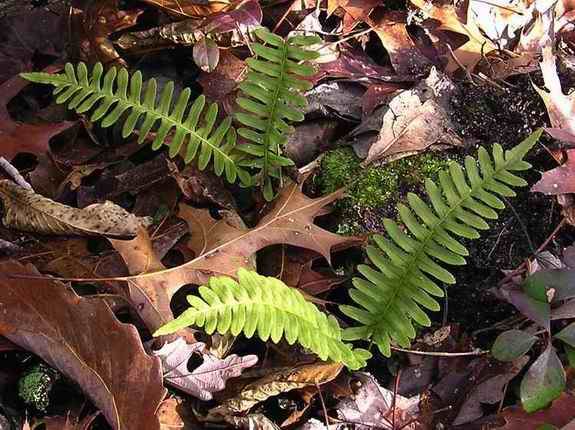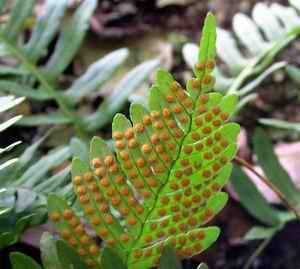|
Return to Hiker's Notebook Home Page
Common Name: Polypody, Polypody of the oak, Wall fern, Brake root, Rock of Polypody, Oak fern, Rock cap fern, Rock Polypody fern, Clach-raineach Chaol (Scottish) The common name Polypody is a shortened form of the generic name.
Scientific Name: Polypodium vulgare var. virginanum - The generic name is from the Greek word for "many" (poly) and "foot" (pous or podos) to indicate the many foot-like pinna that are arrayed along the rachis (the stalk of the fern). Vulgare is from vulgaris, meaning "common" in Latin (vulgar). The local variation (var.) is a Latinized form for Virginia.
The importance of the Polypody to the taxonomy of ferns is evident in their nomenclature. The Class of true ferns was once named Polypodiopsida (now Filicopsida) and the Order Polypodiales contains most fern families. The basic fern structure is thus taxonomically defined by the Polypody, a once-divided or one-cut fern; the individual pinna are broadly connected at the base to the central stem, or rachis. The Polypody grows from a woody underground stem called a rhizome that extends horizontally along the ground. The individual fronds that constitute the asexual phase of the fern life-cycle grow at intervals along the rhizome; the Polypody thus appears in linear groupings that reflect the growth pattern. The asexual phase of the fern life cycle culminates in the production of spores and is therefore called the sporophyte phase. Fern spores are either grouped together on the leaves in structures called sori or are on a separate structure called a fertile frond. Most fern sori are shielded by a flap structure called an indusium that protects them until dispersal is triggered. The spores of the Rock Polypody are in sori located on the underside of the pinna that are closer to the end of the blade, a location that offers greater dispersal. It has no indusium; the spores are relatively unprotected before their release. Successfully germinated spores develop into intermediate sexual structures called prothallia that produce the sperm producing antherium and the egg bearing archegonium. The boggy habitat of ferns reflects their need for a film of moisture so that the male gamete can move to the female gamete to produce the zygote from which the fronds and roots grow. The alternating sporophyte and gametophyte life cycle of the fern is attributed to its evolution from an aquatic to a terrestrial habitat.
The root and fronds of the Polypody fern have been used as an herbal medicine for centuries. Its healing properties were inferred by its association with oak trees, considered by the Druids to invoke special powers. Its principal use was as a purgative or mild laxative, as it was believed to stimulate the secretion of bile from the liver. This alleged hepatic benefit conferred additional palliative attributes to the Polypody, notably in the treatment of jaundice and hepatitis. To this end, the root was harvested beginning in October until as late as February and then dried and ground for subsequent use in powdered form. Like many herbal remedies, the purported generic healing properties of the Polypody carried over to a wide range of maladies.
Polypody root was used to treat joint pain. The English herbalist John Gerard (1545-1612) wrote in The Herbal, General Historie of Plants that "Johannes Mesues reckoneth up Polypodie among those things that do especially dry and make thin: peradventure he had respect to a certain kind of arthritis or ache in the joints: in which not one but many together most commonly are touched." The fronds were gathered in the fall and dried; this being incident to their subsequent decoction into a mucilaginous liquid made by boiling them with sugar. This syrup was used as a treatment for whooping cough in children and more widely as a demulcent to treat irritated or inflamed mucous membranes. For example, it was mixed with honey and applied to the inner membranes of the nasal passage to cure polyps. Polypodium is listed the United States Pharmacopoeia of 1918 for use as "an expectorant in chronic catarrh and asthma." However, it also notes that its odor is "disagreeably oleaginous, its taste peculiar , sweetish, somewhat bitter and nauseous." It has lately been afforded attributes that suggest certain anabolic and androgen-like effects for which it is recommended for increased muscle strength and to enhance sexual activity. |

